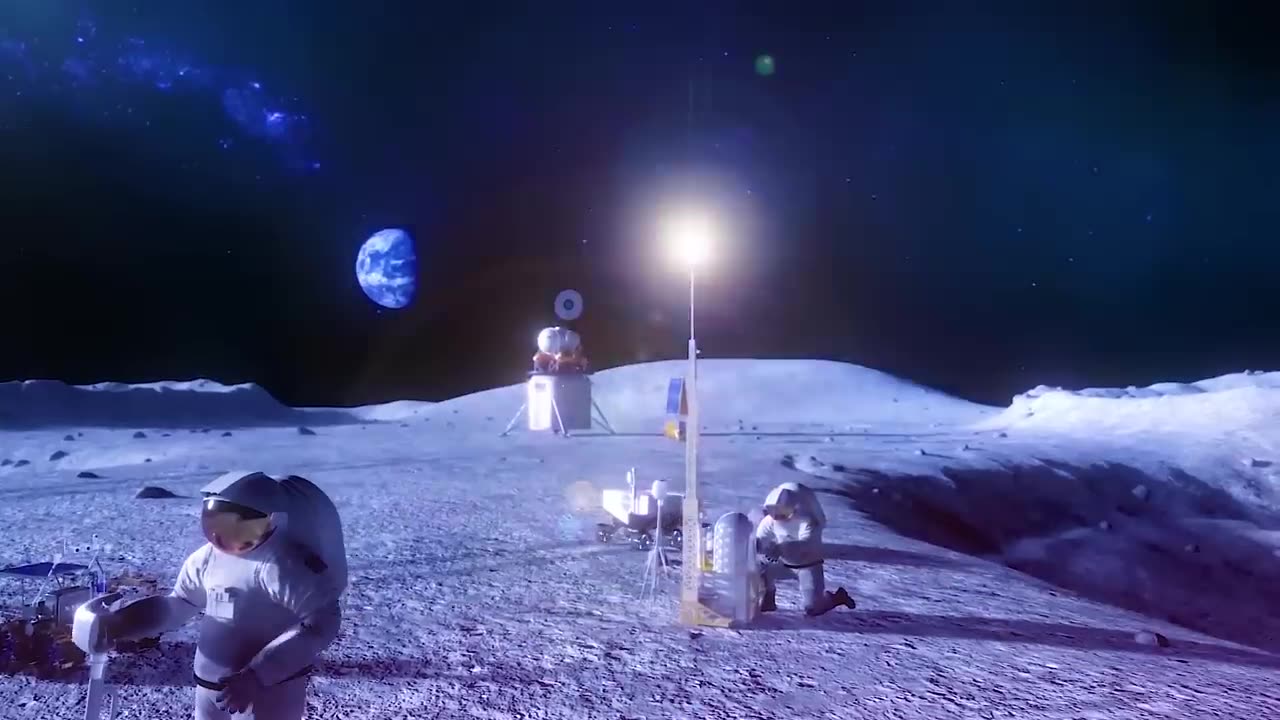Premium Only Content

How Will We Extract Water on the Moon?
Extracting water on the Moon is a crucial aspect of future lunar exploration and potential habitation. Water is valuable for several reasons: it can provide drinking water for astronauts, serve as a source of oxygen through electrolysis, and be used for generating rocket propellant (hydrogen and oxygen) for deep space missions. There are a few methods being considered for extracting water on the Moon:
Lunar Polar Ice: One of the primary sources of water on the Moon is believed to be in the form of ice located at its polar regions. These areas receive very little sunlight, and some craters are in perpetual shadow, allowing water ice to accumulate over billions of years. Extracting this ice involves sending robotic or manned missions to these regions, where specialized equipment could dig, drill, or scrape the surface to gather ice. This ice could then be heated to release water vapor, which could be condensed and collected.
Permafrost Mining: Water molecules are also believed to be embedded in the lunar soil, known as regolith, even in areas where ice isn't directly visible. Mining and processing the regolith to release water molecules is another potential method. This could involve heating the regolith to release water vapor, and then collecting and condensing the vapor.
Solar Hydrogen Production: In this method, solar panels would be used to generate electricity, which could then power an electrolysis process to separate water molecules (H2O) into hydrogen (H2) and oxygen (O2). This is a feasible method for extracting oxygen for breathing and for creating hydrogen for rocket fuel.
Microwave Extraction: Another proposed technique involves using microwaves to heat the lunar regolith. The heat generated would release water vapor from the regolith, which could then be collected and condensed.
Hydrogen Reduction: This method involves using hydrogen as a reducing agent to chemically break down minerals in the regolith that contain bound water. This could release water vapor that can be collected and processed.
Mining Lunar Caves: Some scientists suggest that natural cavities or caves on the Moon could contain ice deposits. These caves could provide an environment where water ice is protected from the harsh lunar surface conditions. Robots or astronauts could explore these caves and extract water if ice is found.
The challenges in extracting water on the Moon include the harsh environment (extreme temperatures, vacuum, and radiation), the need for energy sources, and the development of reliable and efficient extraction technologies. Robotic missions are expected to pave the way for human missions by testing and refining these techniques. As our understanding of lunar water resources grows and technology advances, we'll likely see a combination of these methods being used to extract water and utilize it for various purposes on the Moon.
#NASA: The official hashtag for NASA, covering a wide range of topics related to space exploration, research, and discoveries.
#SpaceExploration: Used for discussions and updates on various space missions and exploration activities.
#MoonMission: Relevant to missions and discussions related to lunar exploration and research.
#MarsMission: Used to follow updates and news about missions to Mars, including the Perseverance rover and other Mars-related projects.
#InternationalSpaceStation: Focused on content related to the ISS, crew activities, and research conducted on the space station.
#Astronomy: For content related to observations, discoveries, and news in the field of astronomy.
#Astrophysics: Used for discussions and updates related to the study of the physical properties and nature of the universe.
#SpaceScience: Covers various scientific aspects of space, including planetary science, astrophysics, and more.
#RocketLaunch: Relevant to posts about rocket launches, whether by NASA or other space agencies.
#HubbleSpaceTelescope: For content related to the Hubble Space Telescope, its observations, and discoveries.
#SpaceTechnology: Covers advancements and innovations in space-related technologies.
#Exoplanets: Used for content related to the discovery and study of exoplanets (planets outside our solar system).
#SpaceDiscovery: Highlights new discoveries and breakthroughs in the field of space science.
#STEM: Relevant for posts related to science, technology, engineering, and mathematics education and careers.
#Astrobiology: For discussions about the search for life beyond Earth and the study of potential extraterrestrial life.
Remember that the popularity and relevance of hashtags can change over time, so it's a good idea to explore social media platforms to see which hashtags are currently trending and widely used for NASA-related content.
-
 UPCOMING
UPCOMING
Chad Prather
12 hours agoHow To Stay Connected To God Amidst A Chaotic World!
9893 -
 LIVE
LIVE
LFA TV
10 hours agoLIVE & BREAKING NEWS! | FRIDAY 10/24/25
2,361 watching -
 LIVE
LIVE
Crypto Power Hour
11 hours agoSolana Treasury Strategy w/ Joseph Onorati, CEO, DeFi Dev. Corp.
1,392 watching -
 12:29
12:29
Clintonjaws
11 hours ago $5.58 earnedShane Gillis vs 'The View' - This Is Priceless!
2.74K4 -
 22:53
22:53
Jasmin Laine
16 hours agoCarney’s Speech BACKFIRES Spectacularly—Liberals PANIC on National TV
2.25K18 -
 1:38
1:38
Jeff Ahern
11 hours ago $0.99 earnedThe Mamdani Effect
2.93K1 -
 LIVE
LIVE
The Bubba Army
21 hours agoNBA BETTING SCANDAL! - Bubba the Love Sponge® Show | 10/24/25
729 watching -
 8:01
8:01
The Gun Collective
13 hours agoBEST new 2011 in 2025? -- Kimber 2K11 Pro Honest Review!
8.77K1 -
 8:49
8:49
Millionaire Mentor
16 hours agoMAGA Vet SHUTS DOWN AOC So Hard She LOST IT
6.35K14 -
 7:25
7:25
The Shannon Joy Show
16 hours agoWhat is the PRIME Act? With Rep. Thomas Massie
9.52K4